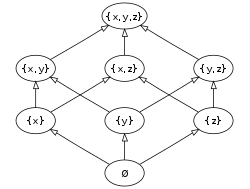
In mathematics, a Dirac measure assigns a size to a set based solely on whether it contains a fixed element x or not. It is one way of formalizing the idea of the Dirac delta function, an important tool in physics and other technical fields.

In mathematics, a Dirac measure assigns a size to a set based solely on whether it contains a fixed element x or not. It is one way of formalizing the idea of the Dirac delta function, an important tool in physics and other technical fields.
A Dirac measure is a measure δx on a set X (with any σ-algebra of subsets of X) defined for a given x ∈ X and any (measurable) set A ⊆ X by
where 1A is the indicator function of A.
The Dirac measure is a probability measure, and in terms of probability it represents the almost sure outcome x in the sample space X. We can also say that the measure is a single atom at x. The Dirac measures are the extreme points of the convex set of probability measures on X.
The name is a back-formation from the Dirac delta function; considered as a Schwartz distribution, for example on the real line, measures can be taken to be a special kind of distribution. The identity
which, in the form
is often taken to be part of the definition of the "delta function", holds as a theorem of Lebesgue integration.
Let δx denote the Dirac measure centred on some fixed point x in some measurable space (X, Σ).
Suppose that (X, T) is a topological space and that Σ is at least as fine as the Borel σ-algebra σ(T) on X.
A discrete measure is similar to the Dirac measure, except that it is concentrated at countably many points instead of a single point. More formally, a measure on the real line is called a discrete measure (in respect to the Lebesgue measure) if its support is at most a countable set.